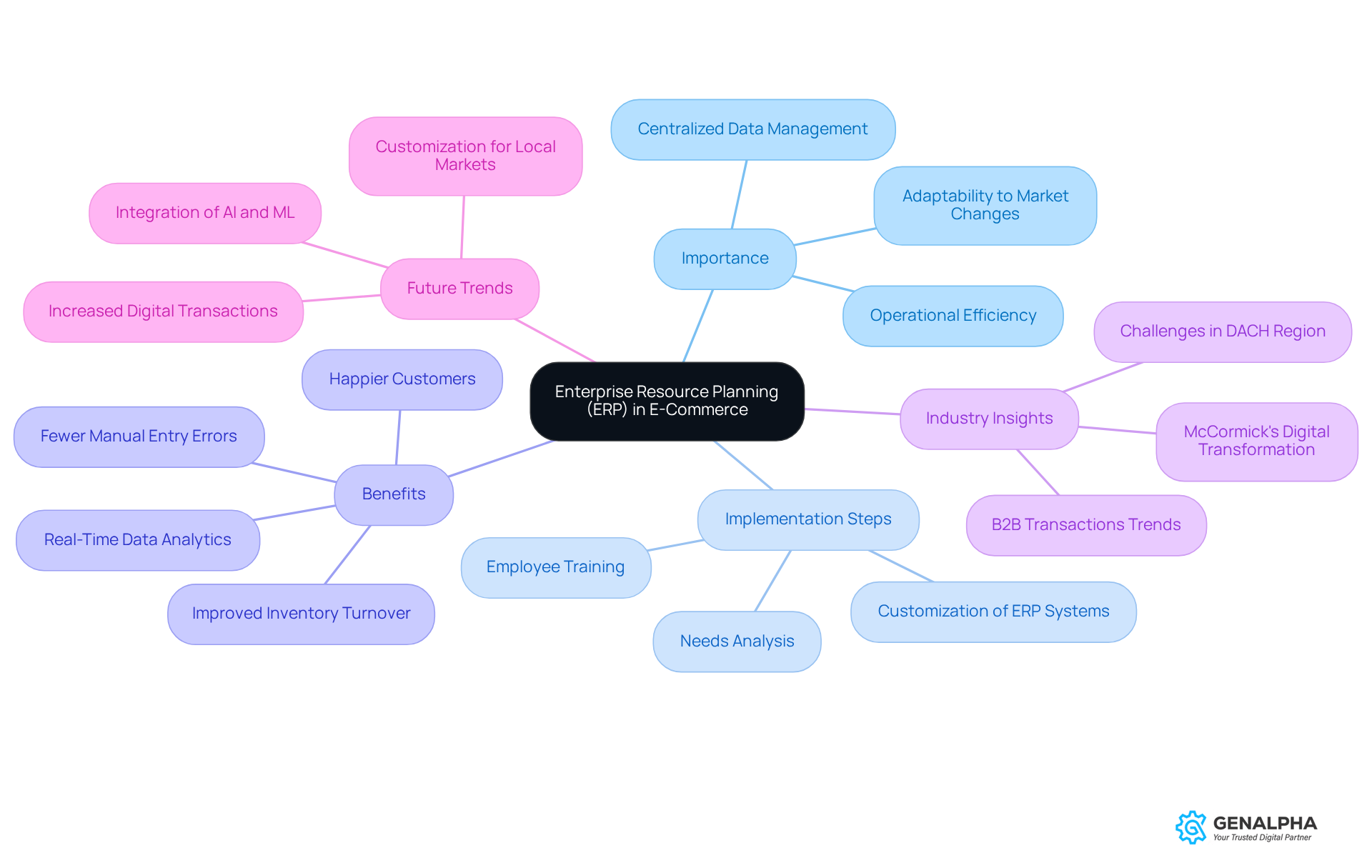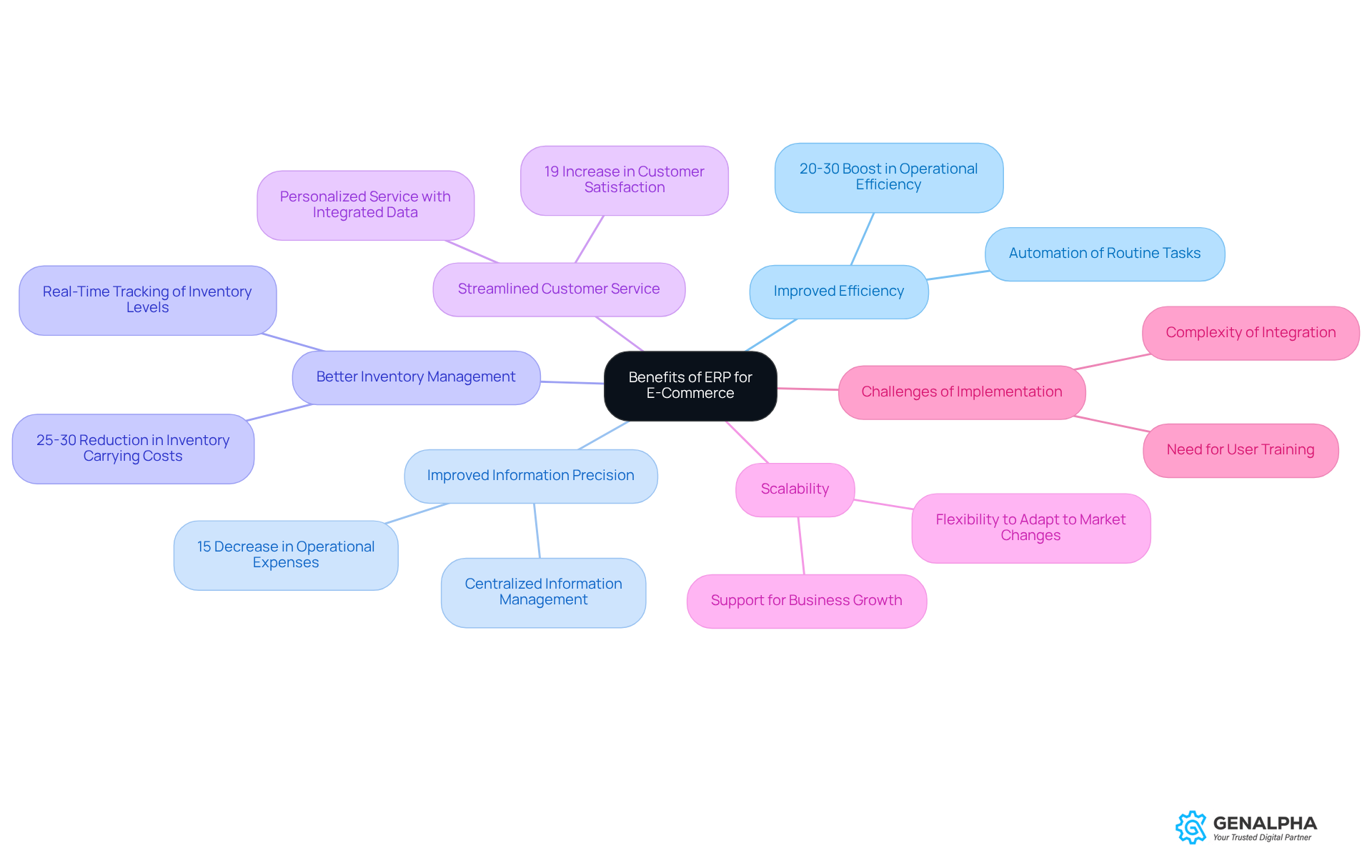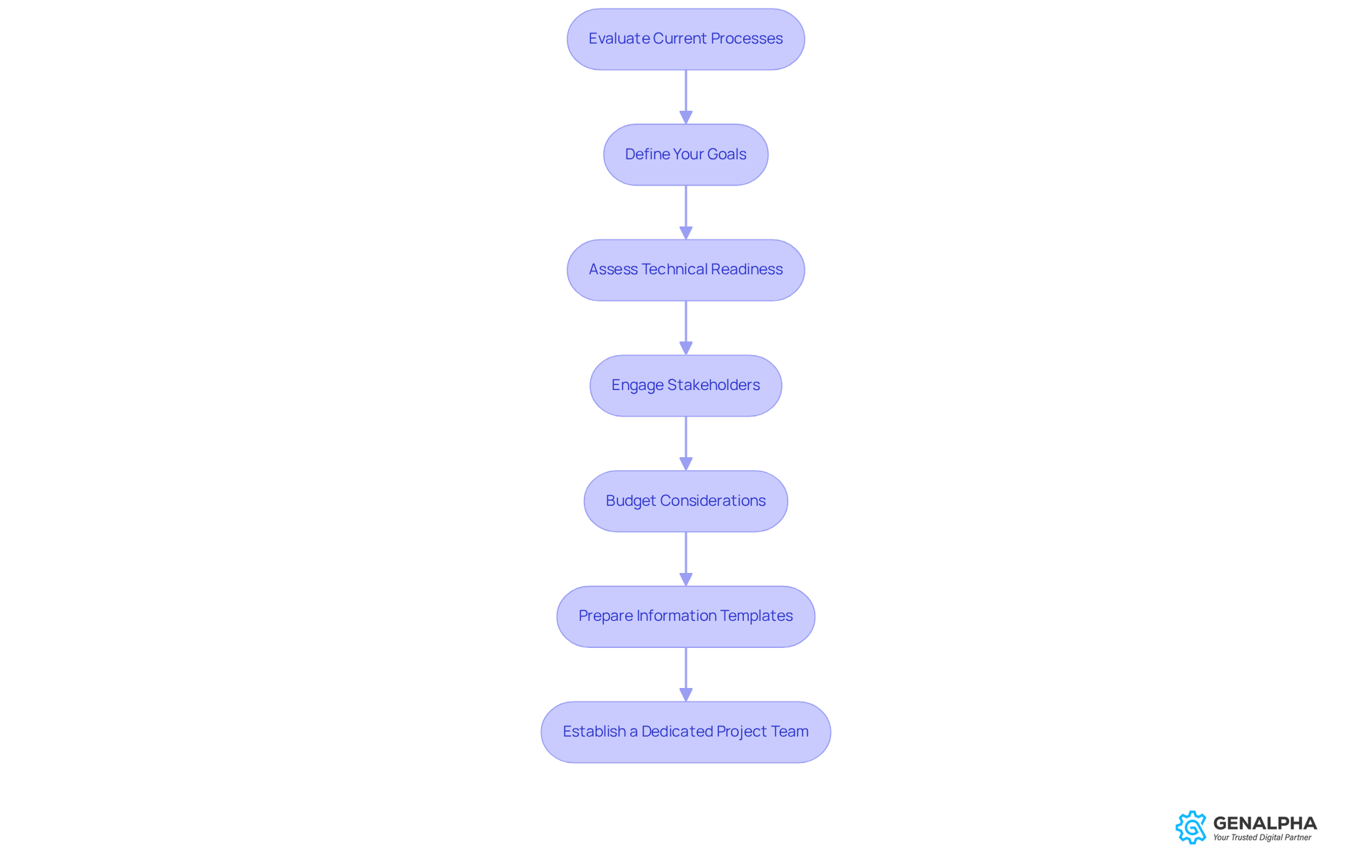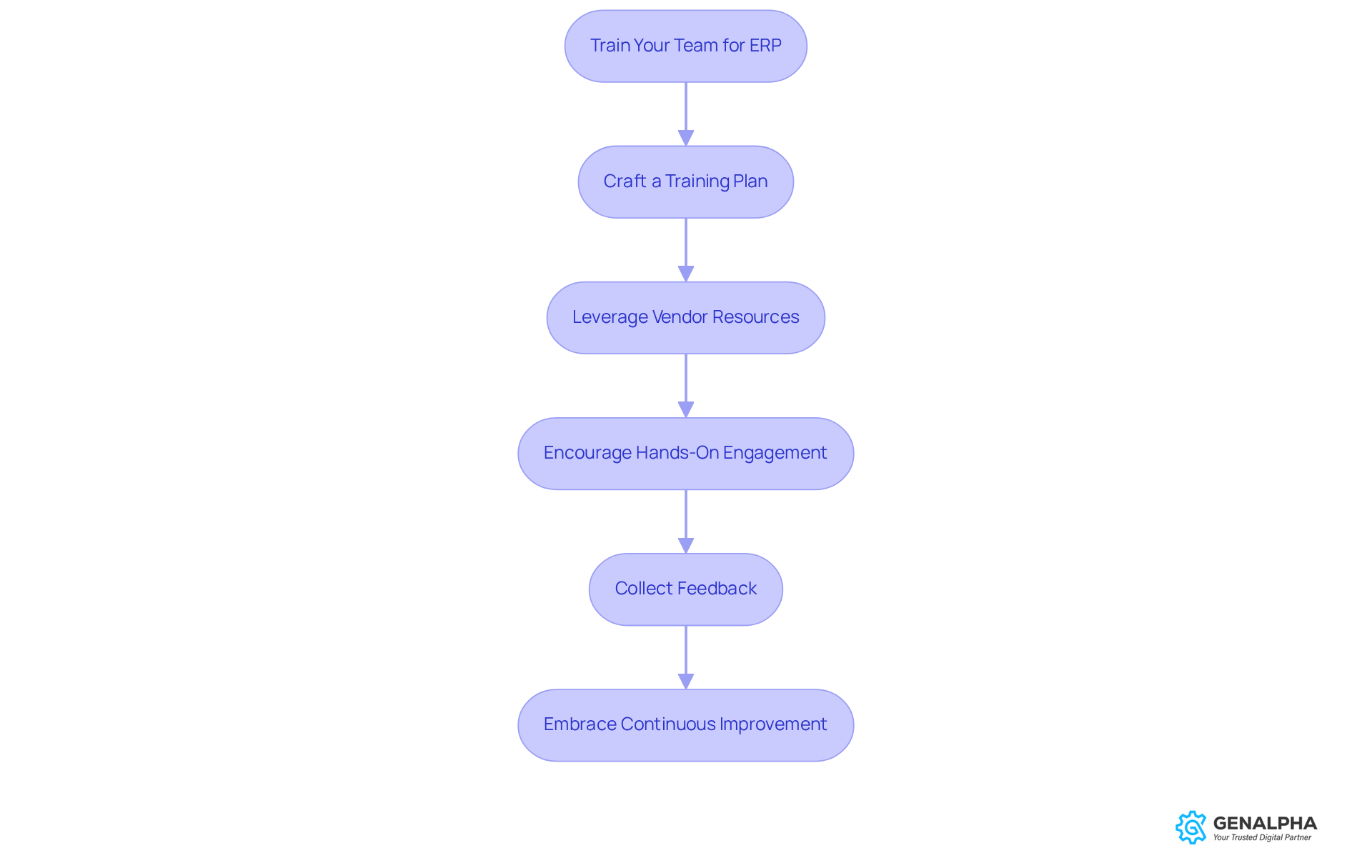Overview
Have you ever wondered how to truly master Enterprise Resource Planning (ERP) in e-commerce? This article is here to be your comprehensive guide! We’ll walk you through the essential steps for a successful ERP implementation and highlight the amazing benefits it can bring to your business.
First off, let’s talk about the key phases you need to consider. We’ll dive into:
- Assessing your business needs
- Choosing the right ERP system
- Training your teams
Why is this important? Because effective ERP solutions can significantly boost your operational efficiency, enhance customer satisfaction, and help you adapt to those ever-changing market conditions.
So, are you ready to take your e-commerce game to the next level? Let’s get started on this journey together!
Introduction
Mastering the ins and outs of Enterprise Resource Planning (ERP) is becoming super important for e-commerce businesses looking to succeed in today’s competitive world. Imagine integrating everything from inventory management to customer relations—ERP solutions can help streamline these processes, boosting efficiency and decision-making. But here’s the kicker: the path to successful ERP implementation isn’t always smooth. So, how can businesses navigate this tricky landscape to unlock the full potential of ERP and really drive growth? Let’s dive in!
Understand the Basics of Enterprise Resource Planning (ERP) in E-Commerce
Enterprise Resource Planning (ERP) is all about managing your organization’s processes in a way that’s smooth and integrated, thanks to some pretty advanced software and tech. In the world of e-commerce, enterprise resource planning in e commerce solutions are essential for managing inventory, orders, customer relationships, and finances all in one place. By centralizing data and automating workflows, these solutions help businesses boost their operational efficiency and adapt quickly to market changes.
So, what does it take to successfully implement ERP in online retail? It starts with careful planning—think thorough needs analysis and solid employee training. Companies that get their ERP solutions right can look forward to some serious perks:
- Improved inventory turnover
- Fewer manual entry errors
- Happier customers due to accurate inventory levels and faster order processing
Plus, with automation in ERP platforms, managing customer inquiries and inventory control becomes a breeze, making operations even smoother.
Industry leaders are really buzzing about the game-changing potential of ERP solutions. Take Brendan Foley, CEO of McCormick, for instance. He points out that their tech investments are vital for managing cost fluctuations and gaining a competitive edge, saying, "Execution, speed, and information intelligence are where we succeed." And as we near 2025, trends suggest that more than half of large B2B transactions will happen through suppliers' digital platforms. This really highlights the need for within the e-commerce space.
The impact of ERP solutions on how organizations operate is pretty significant. They help streamline processes, automate those tedious repetitive tasks, and provide real-time data analytics, which is key for making informed decisions. Plus, when you combine CRM with ERP platforms, you enhance customer interactions, making it essential for businesses looking to thrive in a competitive landscape.
So, are you ready to explore how ERP can transform your operations? Let’s dive in and see how these solutions can make a difference for your business!

Identify the Benefits of ERP for Your E-Commerce Business
Are you considering implementing enterprise resource planning in e commerce for your business? You might be surprised at the benefits it can bring! Let’s dive into some of the key advantages.
- Improved Efficiency: Imagine automating those routine tasks that eat up your time. By doing so, you significantly reduce manual errors and free up your staff to focus on strategic activities. In fact, organizations that adopt ERP systems often see a 20-30% boost in operational efficiency—talk about streamlining workflows and enhancing productivity!
- Improved Information Precision: Have you ever faced discrepancies in your data? Centralized information management can help with that, ensuring all departments are on the same page. This not only improves decision-making but can also lead to a 15% decrease in operational expenses. After all, precise information is crucial for effective financial management.
- Better Inventory Management: Nobody likes stockouts or overstock situations, right? With , you can maintain customer satisfaction. Businesses using ERP solutions often cut inventory carrying costs by 25-30%, aligning stock levels with actual demand. Plus, predictive analytics can forecast demand trends to refine your approach even further.
- Streamlined Customer Service: Imagine having all your customer data integrated at your fingertips. Your team can offer personalized service and resolve issues quickly. Companies that utilize ERP solutions have seen a 19% increase in customer satisfaction thanks to better order precision and faster response times. As Jacob Thomas points out, brands that utilize the synergies between enterprise resource planning in e commerce and ERP platforms are better equipped to compete in today’s dynamic marketplace.
- Scalability: As your business grows, wouldn’t it be great if your ERP solution could keep up without needing a complete overhaul? This flexibility is essential in the fast-paced e-commerce world, where you need to adapt quickly to market changes and customer preferences.
- Challenges of Implementation: Of course, while the benefits are substantial, let’s not overlook the challenges. Implementing an ERP solution can be complex and requires careful planning and resources. Organizations often face hurdles like data migration, user training, and integration with existing systems. Tackling these challenges from the start can lead to a smoother transition and better results.
So, are you ready to explore how an ERP system can transform your e-commerce business? The journey might be intricate, but the rewards can be well worth the effort!

Assess Your Business Needs and Readiness for ERP Implementation
To effectively assess your business needs and readiness for ERP implementation, let’s dive into some essential steps together:
- Evaluate Current Processes: Start by taking a good look at your existing operations. What inefficiencies can an ? Focus on high-value business processes, like order management and inventory control, which can really benefit from automation and integration.
- Define Your Goals: What do you want to achieve with your ERP solution? Maybe it’s reducing order processing times by 20% or boosting inventory accuracy by 15%. Setting measurable targets will help you track the success of your ERP initiative.
- Assess Technical Readiness: Take a moment to review your current IT infrastructure. Can it support the new ERP solution? This means checking hardware capabilities, software compatibility, and any upgrades you might need for a smooth transition.
- Engage Stakeholders: Involve key team members from different departments right from the start. Their insights will be invaluable in understanding current workflows and fostering buy-in. Getting everyone on board is crucial for overcoming resistance to change during implementation. As ECI Solutions points out, resistance to change and failure to adopt new processes are among the biggest risks of ERP implementation failures.
- Budget Considerations: It’s time to develop a comprehensive budget for your ERP implementation. Make sure to include software licensing fees, training costs, and potential downtime during the transition. A realistic budget will help manage expectations and ensure that all necessary resources are allocated effectively.
- Prepare Information Templates: Don’t forget to prepare information templates for the migration process. This step is essential for maintaining data quality and ensuring a smooth transition to the new ERP platform.
- Establish a Dedicated Project Team: Form a dedicated project team with clear roles and responsibilities to oversee the ERP implementation. This structure is vital for managing the complexities of the project and ensuring accountability.
By following these steps, you’ll be better prepared for ERP adoption, ensuring that the solution aligns with your strategic goals and operational needs. Just a heads-up: the phased ERP implementation process typically lasts between 2 to 9 months, so planning accordingly is key!

Choose the Right ERP System for Your E-Commerce Operations
Choosing the right enterprise resource planning in e commerce solution is crucial for enhancing your e-commerce activities, particularly if you're involved in manufacturing or distribution. So, what should you keep in mind?
- Industry-Specific Features: Look for ERP solutions that are tailored for manufacturing and distribution. These systems come with the tools you need to tackle unique challenges, making your operations more efficient and effective.
- Scalability: You’ll want an ERP that grows with you. A scalable system is key for managing more transactions and users as your business expands, ensuring smooth sailing along the way. Research shows that as companies grow, their ERP needs become more complex, so it’s vital to choose a solution that can keep up.
- Ensure that the enterprise resource planning in e commerce system has strong integration capabilities to easily connect with your existing systems, such as e-commerce platforms and CRM tools. This kind of integration is crucial for bringing all your business functions together and improving data flow across departments.
- User Experience: Take a close look at the user interface and overall ease of use. If the setup is too complicated, it can slow down user adoption, so go for an ERP that’s intuitive and user-friendly to help boost productivity.
- Vendor Support: Don’t forget to check out the . Effective implementation and ongoing support are essential for getting the most out of your ERP solution.
Industry experts emphasize that picking the right ERP solution is one of the most significant decisions a manufacturing company can make. Before diving into ERP options, it’s essential to understand your manufacturing style—whether it’s Engineer-to-Order (ETO), Make-to-Order (MTO), or Make-to-Stock (MTS). A well-chosen ERP that emphasizes enterprise resource planning in e commerce not only streamlines your processes but also aligns with your long-term strategic goals, driving growth and enhancing customer satisfaction. So, are you ready to find the perfect ERP for your business?

Implement the ERP System: Step-by-Step Process
Implementing an ERP solution is a journey, and taking a structured approach is key to ensuring success. Let’s break down the process into some essential steps that can guide you along the way:
- Project Planning: Start by crafting a detailed project plan. This should outline . Engaging stakeholders early on not only fosters alignment but also builds commitment—both of which are crucial for your project's success.
- Information Migration: Next up is transferring your existing information into the new system. It’s vital to ensure this information is accurate and complete; after all, mistakes can be costly—up to seven times more to fix later! Prioritizing data cleaning and governance can help you avoid headaches during migration. Remember what Aidan Kennedy said: "If your data isn’t complete and accurate, no amount of configuration and training can make your ERP work."
- System Setup: Now it’s time to tailor the ERP platform to fit your unique operational processes and needs. This might involve configuring software settings and workflows to ensure everything aligns perfectly with your operational goals.
- Testing: Before you go live, conduct thorough testing. This step is crucial for identifying and resolving any issues. Don’t forget integration testing to ensure the ERP solution works seamlessly with your current business applications, setting you up for a smooth transition.
- Go-Live: It’s showtime! Launch the ERP platform and make sure all users know their roles and responsibilities. A phased rollout can help minimize disruptions and allow for quick adjustments based on user feedback.
- Post-Implementation Review: After the launch, it’s essential to assess how everything is performing and gather feedback from users. This ongoing evaluation helps you spot areas for improvement and ensures that your ERP solution stays in tune with evolving business needs. Plus, ongoing support and maintenance are critical for the long-term success of the system.
Real-world examples really highlight the importance of addressing migration challenges. For instance, organizations that focus on data cleaning before migration often find they spend less time fixing issues later, leading to smoother ERP operations. Project managers consistently note that a well-implemented ERP can boost efficiency across all departments—from finance to sales to manufacturing. And let’s not forget, providing ongoing support and training post-implementation is essential for maintaining efficiency and user satisfaction.
So, as you consider your ERP journey, remember that each step you take can make a significant difference. Are you ready to dive in?

Train Your Team and Optimize ERP Usage for Maximum Efficiency
To make sure your team is ready to dive into the ERP system, let’s explore some friendly steps you can take:
- Craft a Training Plan: Start by designing a training program that covers all the ins and outs of the ERP platform, tailored to different user roles. This way, everyone on your team will know exactly what’s expected of them.
- Leverage Vendor Resources: Don’t forget to tap into the and support your ERP vendor provides. These resources can really boost your training efforts and give you insights into the best practices for using the system.
- Encourage Hands-On Engagement: Give your team members the chance to play around with the platform in a safe environment, like a sandbox, before going live. This hands-on experience is key to building their confidence and helping them get comfortable with the ERP functionalities.
- Collect Feedback: Make it a habit to ask users for feedback regularly. This will help you identify where extra training might be needed, refining your program and addressing specific challenges your team faces.
- Embrace Continuous Improvement: Foster a culture of ongoing learning in your organization. Encourage everyone to stay updated on new features and best practices for the ERP system. Remember, continuous education is crucial for maximizing efficiency and adapting to changing business needs. In fact, organizations that train their employees during implementation see a 70% improvement in outcomes within a year, highlighting just how important ongoing education is!
So, what do you think? Ready to get your team on board with these steps?

Conclusion
Mastering enterprise resource planning (ERP) in e-commerce is truly a transformative journey that can redefine how we do business. Imagine integrating functions like inventory management, customer relations, and financial oversight into one cohesive system. This integration can significantly boost operational efficiency and responsiveness to market changes. When we strategically implement ERP, we’re not just streamlining processes; we’re also empowering ourselves to make informed decisions based on real-time data.
Throughout this article, we’ve explored the many benefits of ERP systems. Think improved efficiency, enhanced information accuracy, better inventory management, and the ability to scale operations. It’s clear that thorough planning, assessing our business needs, and selecting the right ERP solution are critical steps in the implementation process. Plus, we can’t forget about training and continuous improvement—they’re essential for maximizing the effectiveness of our ERP systems.
As the e-commerce landscape keeps evolving, embracing ERP solutions is becoming increasingly vital for staying competitive. We should focus not just on the initial implementation but also on fostering a culture of continuous learning and adaptation. By doing this, we can fully leverage the capabilities of ERP systems to drive growth, improve customer satisfaction, and navigate the complexities of the digital marketplace. Taking that first step towards ERP adoption can lead to significant long-term benefits, making it an investment worth pursuing for any e-commerce enterprise. So, are you ready to embark on this journey?
Frequently Asked Questions
What is Enterprise Resource Planning (ERP) in e-commerce?
ERP in e-commerce refers to managing an organization’s processes through advanced software that centralizes data and automates workflows, helping businesses manage inventory, orders, customer relationships, and finances efficiently.
What are the key benefits of implementing ERP in an e-commerce business?
Key benefits include improved efficiency, better information precision, enhanced inventory management, streamlined customer service, and scalability as the business grows.
How does ERP improve operational efficiency?
ERP automates routine tasks, reducing manual errors and allowing staff to focus on strategic activities, often resulting in a 20-30% boost in operational efficiency.
How does ERP enhance information precision?
By centralizing information management, ERP ensures all departments have access to accurate data, which improves decision-making and can lead to a 15% decrease in operational expenses.
What impact does ERP have on inventory management?
ERP provides real-time tracking of inventory levels, reduces stockouts and overstock situations, and can cut inventory carrying costs by 25-30% while using predictive analytics to forecast demand trends.
How does ERP improve customer service in e-commerce?
With integrated customer data, ERP enables personalized service and quick issue resolution, leading to a 19% increase in customer satisfaction due to better order precision and faster response times.
What challenges might businesses face when implementing ERP solutions?
Challenges include data migration, user training, and integration with existing systems, which require careful planning and resources to ensure a smooth transition.
Why is scalability important for ERP in e-commerce?
Scalability allows ERP solutions to adapt as a business grows, ensuring that the system can keep pace with market changes and evolving customer preferences without needing a complete overhaul.




